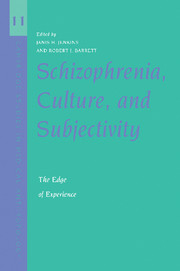Book contents
- Frontmatter
- Contents
- Contributors
- Preface
- Acknowledgments
- Schizophrenia, Culture, and Subjectivity
- Introduction
- Part 1 Culture, Self, and Experience
- Part 2 Four Approaches for Investigating the Experience of Schizophrenia
- Part 3 Subjectivity and Emotion
- 10 Madness in Zanzibar: An Exploration of Lived Experience
- 11 Subject/Subjectivities in Dispute: The Poetics, Politics, and Performance of First-Person Narratives of People with Schizophrenia
- 12 “Negative Symptoms,” Commonsense, and Cultural Disembedding in the Modern Age
- 13 Subjective Experience of Emotion in Schizophrenia
- Index
- References
13 - Subjective Experience of Emotion in Schizophrenia
Published online by Cambridge University Press: 25 January 2010
- Frontmatter
- Contents
- Contributors
- Preface
- Acknowledgments
- Schizophrenia, Culture, and Subjectivity
- Introduction
- Part 1 Culture, Self, and Experience
- Part 2 Four Approaches for Investigating the Experience of Schizophrenia
- Part 3 Subjectivity and Emotion
- 10 Madness in Zanzibar: An Exploration of Lived Experience
- 11 Subject/Subjectivities in Dispute: The Poetics, Politics, and Performance of First-Person Narratives of People with Schizophrenia
- 12 “Negative Symptoms,” Commonsense, and Cultural Disembedding in the Modern Age
- 13 Subjective Experience of Emotion in Schizophrenia
- Index
- References
Summary
… [I]t has appeared both from crude observation and from detailed study of the facial expression that the alleged indifference, apathy, and emotional disharmony of the schizophrenic is more a matter of impression than correct evaluation of the inner experience of such a patient. It has followed that the study of such inner affective experiences by positive objective means seems urgently indicated if the nature of the schizophrenic processes is to be elucidated. Harry Stack Sullivan 1927.
The notion that schizophrenia patients' subjective experience of emotion might not match their facial expressions is not new. Indeed, early theorists, including Sullivan and Bleuler, among others, commented on an apparent discrepancy between what schizophrenia patients reported feeling and what they outwardly expressed to others. Moreover, family members have noted that their ill relatives often report experiencing strong emotions. For example, Bouricius (1989) presented samples of her son's diary writings, which articulated the experience of clear and complex emotions. Nonetheless, psychological research into the emotional features of schizophrenia has lagged behind the astute observations of the early theorists and family members.
In this chapter, we will concentrate on one aspect of the subjective experience of schizophrenia, namely the subjective experience of emotion. In our view, which is shared by a number of psychological researchers, emotions are complex, multichannel systems that have developed through the course of human evolutionary history to help us deal with problems, challenges, and other events and stimuli in our environment.
- Type
- Chapter
- Information
- Schizophrenia, Culture, and SubjectivityThe Edge of Experience, pp. 329 - 348Publisher: Cambridge University PressPrint publication year: 2003



